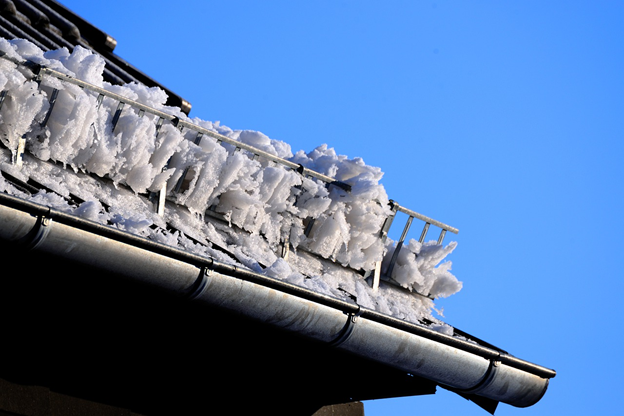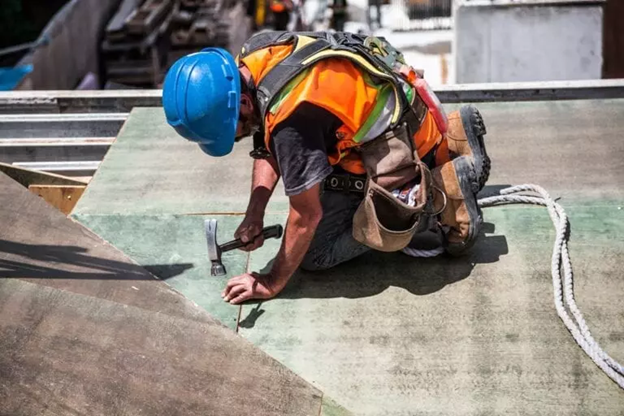The majority of things that could go wrong with a flat roofing system pertain to water exposure. For instance, signs of a damaged roof can include leakage, ponded water, mold growth, an eroded membrane, stains, and more. Therefore, the key to maintaining a healthy and long-lasting commercial property is to ensure that as little water as possible remains on the rooftop. Thanks to the hard work of commercial roof drainage systems, your roof should automatically be well-protected from water exposure. Follow these maintenance tips to keep water flowing steadily through the drainage system and off the roof of your business.
Remove Debris
 Debris such as leaves, sticks, damaged roofing parts, animal remains and excrement is bound to collect over time and eventually stop up your gutters, scuppers and drains. Since debris effectively blocks water from flowing away from the roof, the moisture will instead collect inside the absorbent debris. If left for too long, the stagnant water causes erosion, water stains, and unwanted plant or fungal growth. In addition, a one-inch-deep pool of water weighs five pounds per square foot, which can cause the roofing membrane to sag and weaken over time. Ponded water may also freeze during the colder months, leading to cracks, structural damage or even a collapsed roof.
Debris such as leaves, sticks, damaged roofing parts, animal remains and excrement is bound to collect over time and eventually stop up your gutters, scuppers and drains. Since debris effectively blocks water from flowing away from the roof, the moisture will instead collect inside the absorbent debris. If left for too long, the stagnant water causes erosion, water stains, and unwanted plant or fungal growth. In addition, a one-inch-deep pool of water weighs five pounds per square foot, which can cause the roofing membrane to sag and weaken over time. Ponded water may also freeze during the colder months, leading to cracks, structural damage or even a collapsed roof.
Given how much damage water can wreak, clogs are the number one concern when it comes to keeping your roof drainage systems working correctly. Remember to remove any debris on the rooftop immediately and to clean the gutters regularly. Debris tends to intensify during the autumnal months as the leaves change colors and the trees shed their foliage in preparation for the winter. For this reason, commercial roof repair professionals across the industry highly recommend performing general roofing maintenance, gutter cleaning, tree trimming and debris removal in the fall.
Inspect For Damaged Parts
 A compromised commercial roofing drainage system can show a variety of symptoms, but many of them are aesthetic and therefore easier to spot. Ideally, you should hire a professional roofing contractor to review your entire roof. They will have a much keener eye for recognizing signs of damage than a layperson. However, you are encouraged to perform a preliminary roofing checkup on your own at any point as well. Take a look at the following specific areas, and then call your contractor for any necessary repairs.
A compromised commercial roofing drainage system can show a variety of symptoms, but many of them are aesthetic and therefore easier to spot. Ideally, you should hire a professional roofing contractor to review your entire roof. They will have a much keener eye for recognizing signs of damage than a layperson. However, you are encouraged to perform a preliminary roofing checkup on your own at any point as well. Take a look at the following specific areas, and then call your contractor for any necessary repairs.
First, inspect the drains, bowls, domes and pipes for cracks through which water can escape and cause further structural damage to the building. Cracks that are small enough can be easily repaired with caulk, but parts with larger cracks will need to be replaced. Observe the connections and fastenings around your drains and pipes to make sure nothing looks rusty. Rusted parts need to be replaced before they, too, become leakage points. Next, if any of the flashings appear damaged or loose, you’ll know it’s time to have those replaced. As you walk the entire length of the roof, keep an eye out for tears, punctures, cracks, bubbles or any other type of penetration in the roofing membrane. Double-check the strainers around each drain for loose bolts, and take note of any sagging or loose parts around the gutters and downspouts.
Roofing Water Test
 If you recently noticed leaks and stains all over your ceilings and walls, your drainage system may already be malfunctioning. Unfortunately, it’s not always easy to pinpoint the location and nature of the damaged area. In this case, your expert roofer may opt to conduct a water test, in which a controlled source of water is used to test the internal and external drains, gutters, downspouts and pipes to expose the leakage point. A water test may also offer insight regarding water drainage speed and the presence of ponding water.
If you recently noticed leaks and stains all over your ceilings and walls, your drainage system may already be malfunctioning. Unfortunately, it’s not always easy to pinpoint the location and nature of the damaged area. In this case, your expert roofer may opt to conduct a water test, in which a controlled source of water is used to test the internal and external drains, gutters, downspouts and pipes to expose the leakage point. A water test may also offer insight regarding water drainage speed and the presence of ponding water.
Frequency Of Inspection
 Between clearing away debris, inspecting for damaged parts, and calling your roofing contractor for a water test, maintaining your roof drainage system may start to feel like a full-time job. Thankfully, all of these things only need to be done twice a year. However, it is recommended to perform additional roofing inspections after heavy winds or intense storms, after any roofing construction or maintenance, in autumn after the leaves have fallen, and in spring after the ice has melted.
Between clearing away debris, inspecting for damaged parts, and calling your roofing contractor for a water test, maintaining your roof drainage system may start to feel like a full-time job. Thankfully, all of these things only need to be done twice a year. However, it is recommended to perform additional roofing inspections after heavy winds or intense storms, after any roofing construction or maintenance, in autumn after the leaves have fallen, and in spring after the ice has melted.
In Conclusion: Maintenance Is Power
 A commercial roofing system is only as effective as its maintenance program. Damaged parts of all kinds can lead to water leakage if undiscovered, and a soggy pile of leaves can single-handedly render an entire drainage system useless if left untreated. If you don’t have one already, discuss a biannual maintenance plan with your trusted roofing professional. Preventative maintenance has the power to keep your drainage system working night and day and protect the people and assets inside the building.
A commercial roofing system is only as effective as its maintenance program. Damaged parts of all kinds can lead to water leakage if undiscovered, and a soggy pile of leaves can single-handedly render an entire drainage system useless if left untreated. If you don’t have one already, discuss a biannual maintenance plan with your trusted roofing professional. Preventative maintenance has the power to keep your drainage system working night and day and protect the people and assets inside the building.


